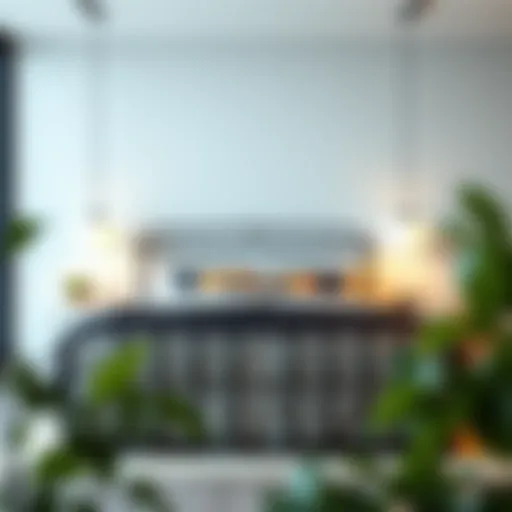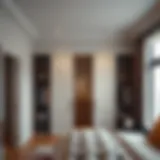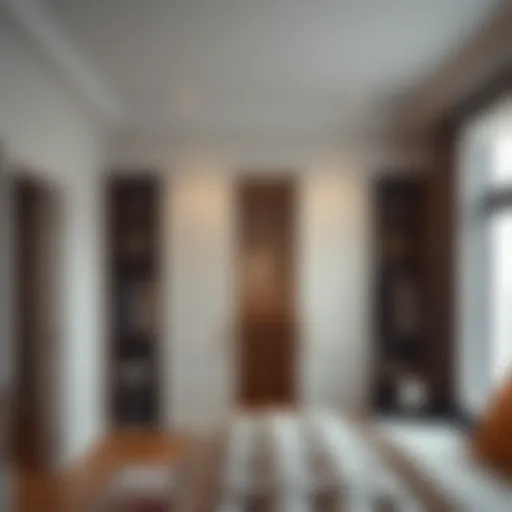Comprehensive Guide to LED Strip Lighting Applications

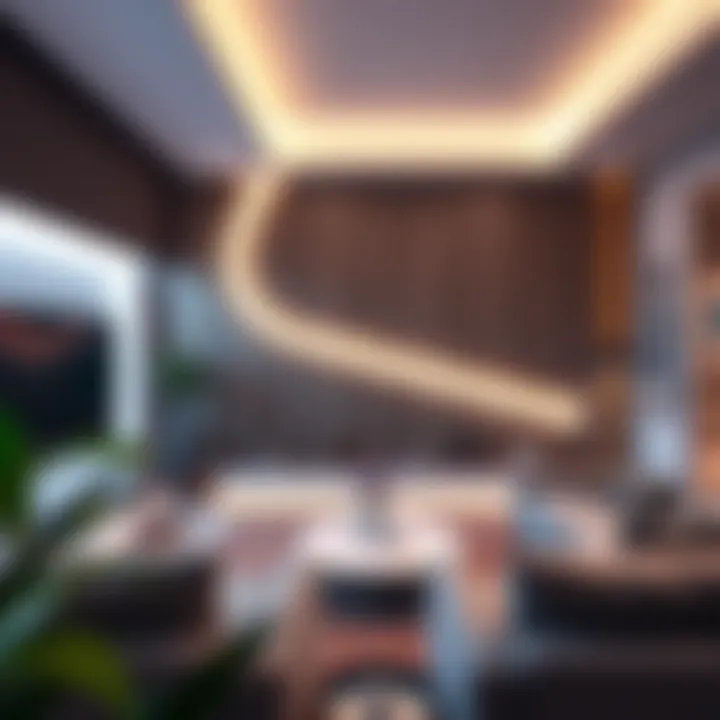
Intro
In today’s rapidly evolving world of interior design, where aesthetics meets functionality, LED strip lighting has emerged as a game changer. No longer merely a practical solution, these flexible light strips offer endless possibilities for creativity and personalization in various spaces, from residential to commercial settings. Homeowners, decorators, and DIY enthusiasts alike are discovering the transformative power of LED strips, whether they're accentuating architectural features or simply providing ambient illumination.
From their energy efficiency to diverse color options, LEDs provide flexibility that many traditional lighting solutions lack. Moreover, with the rapid advancements in technology, incorporating these lighting solutions into homes and workplaces is more straightforward than ever. This article embarks on a thorough exploration of LED strip lighting, focusing on its applications, choices available in the market, and tips for installation, ensuring readers are well-equipped to make informed decisions that suit their unique styles and requirements.
Design Trends
Contemporary Styles
Minimalist Approach
The minimalist trend has taken the design world by storm. In this context, LED strip lights shine as a perfect accompaniment. They're often installed discreetly under cabinetry or around ceilings, offering a clean, uninterrupted look. With the ability to select subtle hues, homeowners can maintain a tranquil, uncluttered aesthetic, perfect for modern spaces that prioritize simplicity.
Statement Lighting
Conversely, many homeowners are opting for bold statement pieces that command attention. LED strips can be positioned to create dramatic effects, illuminating artwork or accent walls in vibrant colors. This approach is particularly popular in entertainment spaces or areas meant to inspire creativity, such as home offices and studios.
Vintage Inspirations
While contemporary designs are trending, there’s also a notable rise in vintage inspirations. Designers are looking to the past for ideas, seamlessly blending the charm of yesteryears with modern tech. LED strips can replicate the warm glow of vintage bulbs when placed strategically, allowing a nostalgic feel without sacrificing energy efficiency.
Material Innovations
Sustainable Materials
As environmental concerns continue to grow, many manufacturers are now focusing on sustainable materials for LED products. This shift is crucial, as consumers increasingly opt for eco-friendly lighting solutions. Manufacturers are incorporating recycled materials, which reduces waste while still offering robust, high-quality products that meet various design aesthetics.
Smart Furniture Technology
Another fascinating trend involves integrating LED strip lighting into furniture. Think coffee tables with built-in lighting or bookshelves that light up when you approach them. These innovative combinations of design and technology not only enhance functionality but also add a unique twist to traditional furniture pieces, making them stand out.
By embracing these design trends and innovations, design enthusiasts can create spaces that are both aesthetically pleasing and sustainable.
Suggestions for further reading include:
As we examine the nuances of LED strips further in this article, the aim is to make the world of lighting more accessible and inspiring to every reader, no matter their level of expertise.
Prelude to LED Strip Lighting
LED strip lighting has carved a niche for itself in modern decor, evolving from a simple lighting solution into a significant element in the design landscape. This article serves as a comprehensive guide that peels back the layers of LED strip lights, uncovering their vast potential and diverse range of applications. From providing ambient lighting in residential spaces to enhancing commercial environments, these flexible strips can be tailored to virtually any need.
The importance of understanding LED strip lighting lies in its composition and characteristics. Unlike traditional lighting, LED strips offer a host of benefits, including energy efficiency, easy installation, and adaptability. As energy-saving technologies gain traction, LED strips come equipped with various options to fit different preferences and applications, whether that’s for mood lighting or task lighting.
Moreover, as we dive deeper into the specifications, applications, and installation techniques, it's apparent that choosing the right LED strip can significantly elevate not just aesthetics but also functionality in any given space. Whether you're a homeowner looking to revamp your living room or an interior designer wanting to make a statement, understanding LED strip lighting is essential.
Definition and Basic Principles
LED strip lighting is essentially a flexible circuit board populated with light-emitting diodes (LEDs). These strips can be found in various lengths and are often backed with adhesive for easy attachment to surfaces. The basic principle behind their operation revolves around the way LEDs generate light. Instead of using filaments or gas, LEDs convert electrical energy directly into light, making them far more efficient than traditional incandescent or fluorescent options.
An LED strip typically consists of multiple small LEDs arranged closely together to create a continuous band of light. This configuration leads to smooth illumination and the capability to produce vibrant colors, supporting both RGB setups and single-color variations. Thanks to their low heat emission, LED strips are ideal for placement in creative nooks and crannies that require illumination without the risk of heat damage.
In essence, the physics of LED lighting holds the key to its popularity. With a straightforward mechanism and a wide array of functionalities, they cater to both the practical and aesthetic needs of users.
Historical Context
The journey of LED lighting began in the early 20th century, with the first visible spectrum LED developed in 1962 by Nick Holonyak Jr. Initially, the application of LEDs was limited, primarily used in indicators and displays. However, as technology progressed and the efficiency of LEDs improved, their use burgeoned across various fields.
By the 1990s, a significant turning point was reached when blue LEDs were invented, enabling the creation of white light through combinations of RGB colors. This breakthrough opened the doors for LEDs to infiltrate residential lighting. Since then, improvements in manufacturing and reductions in cost have transformed LEDs from a niche product to a prominent lighting solution in homes and businesses alike.
Today, LED strips are ubiquitous, found not just in homes but also in advertising, art installations, and even automotive lighting. Their evolution is a testament to technological advancements and reflects changing demands in the lighting market, where energy efficiency and versatility take precedence.
"The history of LED technology is a tale of ingenuity and adaptation, marking a shift toward more sustainable lighting solutions."
In summary, the introduction of LED strip lighting represents a merging of efficient technology with modern aesthetics, allowing individuals to enhance their spaces in innovative ways.
Types of LED Strips
Understanding the types of LED strips is crucial for anyone looking to enhance their living or work spaces through innovative lighting. Each type comes with its own unique features, advantages, and considerations that cater to different needs and preferences. The right choice of LED strip can make or break a design scheme, impacting not only the aesthetics but also the functionality of the space.
Flexible vs. Rigid Strips
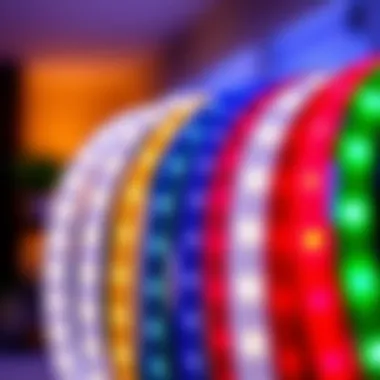
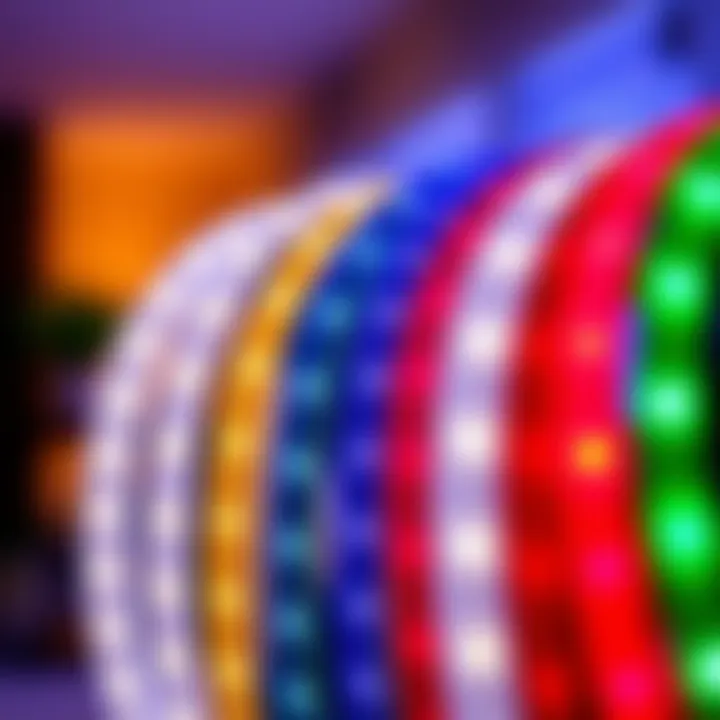
Flexible LED strips are, as the name implies, easily bendable and can conform to a variety of shapes and surfaces. This flexibility makes them ideal for installations in intricate spaces, such as around the contours of furniture or in non-linear arrangements. On the flip side, rigid strips maintain a solid form, which can be beneficial for straight runs along walls or for features like cove lighting.
Advantages of flexible strips include:
- Versatility: They can fit into tight spaces.
- Adaptability: Easy to cut to length or connect pieces together.
- Creative potential: Ideal for unique designs or artistic installations.
In contrast, rigid strips tend to offer:
- Stability: More durable for long linear applications.
- Light Distribution: Generally provide an even light spread over a longer area.
Both types have their place, and the choice depends on the specific setup or design goal.
Color Temperature Variations
Color temperature plays a significant role in setting the mood of a space. Variations from warm to cool lighting can completely alter the perception and usability of an area.
Warm White
Warm white LED strips create a cozy and inviting ambience. Typically rated between 2700K to 3000K, they mimic the soft glow of incandescent bulbs. This warmth provides a comfortable setting, making it a go-to choice for living rooms and bedrooms where relaxation is paramount.
Key characteristic: The gentle hue fosters a sense of comfort, encouraging a homey feel. Having warm white lighting in spaces like dining areas can enhance social interactions, creating an inviting atmosphere around the dinner table. However, a downside might be that it can make spaces appear smaller due to lower light intensity.
Cool White
Cool white options, ranging from 4000K to 5000K, shine with a bright clarity that resembles daylight. This makes it a valuable choice for task-oriented areas like kitchens, offices, or workshops. The crispness of cool white lights helps to improve concentration and visibility while providing an uplifting ambiance.
Key characteristic: Cool white is valued for its efficiency in highlighting details, making spaces feel larger and more open. Nevertheless, it may not be suitable for cozy environments, as some people find it less inviting than warm alternatives.
Daylight
Daylight lamps, usually around 5000K to 6500K, offer a stark brightness intended to mimic natural light. Ideal for spaces where clear visibility is essential, such as galleries or retail spaces, daylight LED strips can energize a space and highlight colors vividly.
Key characteristic: They embody a neutral tone that enhances the true colors of decor. However, using daylight strips in a residential setting, especially in spaces meant for relaxation, may create a harsh or clinical feel, possibly overwhelming the senses.
RGB vs. Single Color Strips
RGB strips utilize Red, Green, and Blue diodes to produce a full spectrum of colors. This color-changing capability allows for dynamic effects that can set different moods or themes. On the other hand, single color strips focus on one hue, providing consistent illumination without the variability that RGB offers. Both variants have distinct applications depending on personal taste or desired outcomes in design.
Waterproof Options
Waterproof LED strips are designed to withstand moisture and are perfect for areas such as bathrooms, outdoor spaces, or kitchens. These strips usually have specialized coatings or housings to protect them from exposure to water and humidity. Not only do they ensure safety and longevity, but they allow for creativity in traditionally difficult spaces without the worry of malfunction.
Key Specifications to Consider
When it comes to selecting LED strip lighting for your space, understanding the key specifications is not just a matter of preference; it's an essential foundation for achieving optimal results. Choices regarding lumens and brightness, voltage, and durability through IP ratings may seem mundane at first glance, but they are pivotal in ensuring your lighting project meets both aesthetic and functional goals. Let's dive into these elements to help you make informed decisions for your lighting needs.
Lumens and Brightness
The measurement known as lumens indicates the total amount of visible light emitted by a source. In the realm of LED strip lights, it’s crucial to gauge how bright the lights will be in your desired space. For instance, when choosing between a strip that outputs 300 lumens per meter versus one that outputs 800 lumens per meter, your choice will significantly affect the ambiance. A kitchen, laden with midway cabinets and workspaces, might benefit from an 800-lumen strip to ensure clarity and visibility, while a softly lit bedroom could do well with a gentler 300-lumen option.
- Consider your environment: Areas meant for productivity or intricate tasks typically require brighter lighting, while spaces designated for relaxation might merit a softer touch.
- Layering can enhance lighting: Don't hesitate to mix lumens—using both brighter and dimmer strips can create depth and varied textures in a room.
Voltage and Power Consumption
Voltage is another key consideration that influences not only how the LED strips function but also their energy efficiency. Standard LED strips are often available in 12V or 24V options. The selection isn't arbitrarily made; different voltages can affect brightness, ease of installation, and installation efficiency. A 24V strip can often provide more lumens per watt and reduces voltage drop, which means a steadier light even over long distances.
- Look at the bigger picture: High power consumption might lead to higher electric bills over time, so always checkout how your chosen strip performs in terms of power draw versus output.
- Transformative technology: Some newer options feature smart capabilities that allow you to control power consumption more effectively, potentially saving you money in the long run.
IP Ratings for Durability
The ingress protection rating, or IP rating, is a crucial spec to ponder when choosing LED strips, especially in environments susceptible to humidity or dust. An IP rating typically consists of two digits— the first often related to solid particle protection and the second to moisture protection. For example, an IP65 rating means that the strip is dust-tight and can withstand water jets, making it ideal for outdoor or moisture-prone areas like bathrooms and kitchens.
"An informed decision comes from understanding the environment where lighting will be used and knowing how durability is quantified."
- Evaluate your needs: If you’re considering lights for an outdoor patio, look for IP ratings of 67 or higher to guarantee they can withstand various weather conditions.
- Indoor applications vary: For indoor use, most strips with a lower IP rating can suffice unless they're placed in a high-moisture area.
By keeping these specifications in mind, whether you're a homeowner looking for the perfect accent to your room, or a designer aiming for cohesive aesthetics, you'll be better positioned to make decisions benefiting both style and practicality. The right lumens, voltage, and durability can transform an average space into something remarkable.
Applications of LED Strips
LED strip lights have carved a niche in modern lighting solutions, owing to their versatility and efficiency. Their applications stretch across various domains, from enhancing everyday residential spaces to amplifying commercial aesthetics, and even transforming architectural designs. Understanding the numerous ways in which LED strips can be utilized is crucial for decorators, homeowners, and interior designers who wish to employ innovative lighting solutions.
Benefits of LED Strip Applications
The primary draws of these strips include their customizable lengths, colors, and ease of installation. This adaptability means they can fit into nearly any design scheme or functional need. They allow for creative expression in how spaces feel. Moreover, they offer energy efficiency, outshining traditional lighting options, which is critical in today’s environmentally conscious world.
When it comes to applications, there's more than meets the eye. Each different usage points towards the growing trend of personalized spaces and corporate settings that foster creativity and productivity through thoughtful lighting choices.


Residential Lighting Solutions
In residential settings, LED strips serve multiple purposes. From accent lighting to comprehensive room illumination, they fit well in kitchens, bedrooms, or living areas. For example, using LED strips under cabinets not only adds a functional light source for cooking but can also create a cozy ambiance.
Furthermore, varyin g color temperature allows homeowners to shift the mood of a room with a touch of a button. Warm tones can make a space feel inviting, while cooler tones can help energize a home office. This variability makes them a highly popular choice in home decorating.
Commercial Uses
Retail Displays
Retail spaces have increasingly adopted LED strip lighting for display and signage. This choice not only draws customer attention but also creates an atmosphere that can enhance the shopping experience. One significant characteristic of retail displays that utilize LED strips is the vibrancy of color that can be achieved. This is particularly beneficial in enticing potential buyers, creating visual interest that can lead to increased sales.
A unique feature of these displays is that they can be programmed to change colors or patterns. Such adaptability allows for dynamic promotions or seasonal displays that keep the environment engaging. On the downside, overuse of vibrant colors may overwhelm some customers, so a balanced approach is needed.
Office Environments
In office settings, LED strip lighting serves functional and aesthetic purposes. The clean, modern look of LED strips can uplift a workspace, fostering a more innovative atmosphere. A key characteristic here is their low heat emission, which can enhance comfort levels for employees. The ability to use different color temperatures allows for adjustable lighting scenarios that can either calm anxiety during busy workdays or energize teams during brainstorming sessions.
However, one must keep in mind the placement of LED strips in office environments. If not installed correctly, they can create glare or harsh shadows, which could detract from productivity. So, careful consideration regarding placement and type of lighting is crucial in these applications.
Architectural Applications
Architectural use of LED strips defines modern buildings in a unique light. They are prevalent for highlighting structural features and guiding visual pathways in both the interior and exterior. For instance, LED strips can accentuate the edges of ceilings or coves, offering a sleek, contemporary look.
Moreover, incorporating LED strips in facades allows for dramatic lighting effects that can be altered for holidays or community events, presenting a shift in how buildings interact with their environments. However, it's essential to choose types that withstand outdoor elements, especially if installed in exposed areas.
These creative applications of LED strips not only serve practical purposes but also enhance the aesthetics and functionality of various spaces, proving their worth as a valuable lighting solution.
Creative Ways to Use LED Strips
LED strip lighting isn’t just about functionality; it becomes a canvas for creativity, transforming mundane spaces into vibrant environments. With their versatility, LED strips can marvellously enhance aesthetic appeal while serving practical purposes. Understanding these innovative applications allows homeowners, interior designers, decorators, and DIY enthusiasts to think outside the box and leverage these lighting solutions effectively.
Backlighting Furniture and écor
Backlighting is one of the most striking methods to make furniture and décor pop. Adding LED strips behind items like your favorite painting, bookshelf, or even a headboard creates an eye-catching halo of light. This technique not only emphasizes the features of the objects but also creates depth in the room.
- Considerations: Make sure to choose the right color and intensity. Soft warm whites can add warmth and coziness, while bright whites can give a modern, sleek feel.
- Installation Tip: Use a dimmer switch for more control. You can easily adjust the brightness depending on the mood or occasion.
"Sometimes, the simplest touches—like backlighting—can completely redefine your space."
Coffered Ceilings and Trims
Coffered ceilings are often seen as a hallmark of traditional architecture, but by integrating LED strip lights, you can give them a contemporary twist. Installing strips within the coffers or along the trim provides an understated elegance that can transform flat ceilings and walls into engaging art.
- Benefits: This method adds dimension and can reflect your style—be it rustic, modern, or minimalistic. It can also improve the room's overall ambiance, offering a soft glow that can be adjusted based on the time of day.
- Installation Tip: Plan your layout carefully to ensure even light distribution and avoid harsh shadows. You might want to consult tutorials or guides specific to installing lighting in coffered ceilings.
Under Cabinet and Shelf Lighting
Under cabinet and shelf lighting is yet another effective application of LED strips that many homeowners overlook. By illuminating countertops or shelves, you can enhance visibility while also boosting the aesthetics of the space. This is particularly helpful in kitchens and studies where functional lighting is key.
- Installation Ideas: Place the strips right under the lip of the cabinet or shelf for a clean look. This way, light bounces down gracefully onto the surfaces.
- Functionality: Not only does it make tasks like meal prep or reading easier, but it also gives an inviting feel, especially in open-concept spaces.
In summary, using LED strips creatively can elevate your interior design game. By implementing backlighting, enhancing architectural details, or adding functional under-cabinet lighting, you can create spaces that are not only beautiful but also meet your specific needs. With the right approach, LED strips become more than just lights—they become integral pieces of your home's narrative.
Installation Tips and Techniques
When it comes to LED strip lighting, the installation process is crucial. Proper installation not only ensures optimal functionality but also maximizes the aesthetic appeal. A well-planned installation can make a significant difference in how the lighting integrates with the overall design of a space. This section examines the essential tips and techniques for successfully installing LED strip lights, focusing on preparation, mounting methods, and the intricacies of connecting and wiring.
Preparation and Planning
Before diving into installation, a clear plan must be laid out. This includes evaluating the space where the LED strips will be placed. Understanding the dimensions, potential obstructions, and the desired lighting effect can guide your choices, making the installation smoother.
- Measure Twice, Cut Once: Ensuring that the strips fit perfectly in your desired area is key. Take accurate measurements of the length needed, considering any corners or turns where adjustments may be needed.
- Consider Power Sources: Identify where the power sources are located. This will affect installation decisions and ensure that you don’t have unsightly wires dangling. Planning the layout helps to integrate the strips seamlessly into the overall design.
- Choose the Right Tools: Gather all necessary tools before starting. Common tools include scissors for cutting the strips, wire strippers for connections, and a level for ensuring mounting accuracy.
Having a solid plan not only saves time but also avoids unnecessary hassle during the installation process.
Mounting Methods
Selecting the right mounting method is essential for the durability and performance of LED strips. Here, we consider two popular options: adhesive strips and brackets.
Adhesive Strips
Adhesive strips offer a straightforward solution for mounting LED lights. They provide a simple peel-and-stick application that caters to a wide variety of surfaces, such as walls, cabinets, and furniture.
- Key Characteristic: Adhesive strips are incredibly versatile and easy to use. Their installation process is often quicker than other methods, making them a favorite among DIY enthusiasts.
- Benefits: An attractive feature of adhesive strips is their flexibility. They can be repositioned without damaging the surface, although repeated repositioning might weaken their sticking power over time.
- Disadvantages: However, while they’re convenient, adhesive strips might not hold up well in high-temperature areas, such as under cabinet lighting that generates heat.
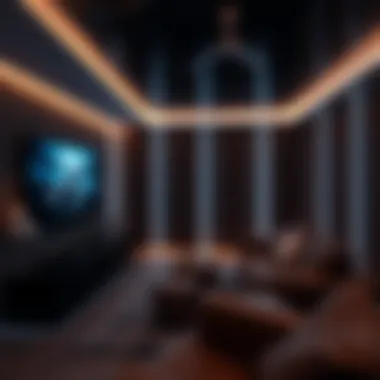
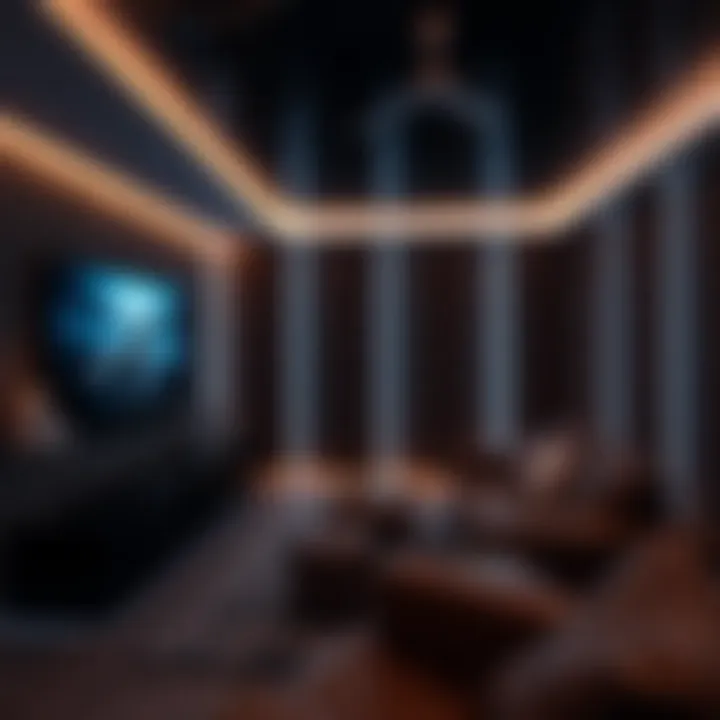
In short, this method is beneficial for users who seek a hassle-free installation experience.
Brackets
On the other hand, brackets provide a more robust mounting solution. They require additional time and hardware but can offer greater stability and durability for LED strips, especially in permanent installations.
- Key Characteristic: Brackets are typically made from materials like plastic or metal and can hold the strips firmly in place.
- Benefits: Their secure installation means that strips won’t sag or peel away over time. This makes them a recommended choice for longer runs of lights that may endure more wear and tear.
- Disadvantages: Installation with brackets involves drilling and may take longer, which could be a downside for those looking to avoid any potential damage to surfaces.
Overall, choosing between adhesive strips and brackets will depend on the specific needs of your project and the environment where the lights will be used.
Connecting and Wiring
Once the strips are securely mounted, the next step involves connecting the LED lights to a power source. Understanding how to wire these strips effectively is vital for both safety and functionality.
- Inspect the Connectors: Be sure to check that the connectors are compatible and that they fit snugly. Loose connections can lead to flickering lights or the possibility of shorts.
- Follow Manufacturer Instructions: Each product may have unique wiring configurations, thus following the guidelines is crucial. Typically, LED strips come with a connector that makes wiring easy, and some may offer optional connectors for more complex installations.
- Test Before Finalizing: Always conduct a test of the lights before permanently securing them. This allows for adjustments and ensures that everything is functioning correctly without the hassle of uninstalling strips later if issues arise.
By taking the bidding steps during installation, you’ll set the stage for a successful LED strip lighting project that enhances the beauty and functionality of your space.
Maintaining LED Strip Lighting
Maintaining LED strip lighting is one vital aspect that significantly contributes to their longevity and performance. Regular upkeep not only enhances the aesthetics of your environment, but also ensures these lighting solutions run efficiently for years. A well-maintained LED strip can save costs associated with energy consumption and replacement.
Cleaning and Care
Cleaning LED strips is simpler than one might think. The first thing to note is that they often attract dust and grime, particularly in areas with high foot traffic or in kitchens. Fortunately, keeping them clean is achievable with a few straightforward steps.
- Turn Off Power: Always ensure the power is off before embarking on any cleaning, which minimizes the risk of an accidental electric shock.
- Gentle Wipe: Use a soft cloth dampened with a mild detergent solution. Avoid any abrasive cleaning agents, as these might scratch the surface.
- Dry Thoroughly: After cleaning, it's crucial to dry the strips properly. Unwanted moisture can lead to corrosion and eventual failure of the lights.
Regular cleaning can help in preventing clogs that may affect the brightness and color.
Troubleshooting Common Issues
While LED strip lighting generally requires minimal maintenance, issues can arise. Knowing how to tackle common problems can enhance your overall experience.
Dim Lights
Dim lights can occur due to various reasons. Commonly, a poor connection or a drop in voltage may be the culprits. It’s important to note that dimming affects the overall mood and usability of the space. When lights aren’t bright enough, it can create a gloomy atmosphere, which is certainly not the intention.
Key characteristics like brightness can be influenced by the quality of the power source. Often, dim lights suggest an underpowered strip, or one that may be nearing the end of its lifespan, making it less energy-efficient. In environments where lighting is crucial, addressing dim lights promptly is essential to maintain functionality and comfort.
Flickering Effects
Flickering effects are another issue that users sometimes encounter with LED strips. This irregular behavior can be not just annoying but also indicative of underlying problems. Flickering often points to an inconsistent power supply or faulty wiring.
The unique feature of flickering is that it can be caused by dimmers, especially if they are not compatible with LED technology. Such flickering is generally more prevalent in older setups. Troubleshooting this issue may require replacing dimmers with compatible options or ensuring wiring is correctly done. Following up with the right adjustments can ensure your LED strips provide a steady ambient glow rather than an erratic visual experience.
Understanding these maintenance aspects can prevent small issues from snowballing into costly repairs or replacements later. Awareness combined with proactive care can ensure that LED lighting performs without a hitch.
Final Thoughts on LED Strip Lighting
LED strip lighting has become a significant part of modern design, and its versatility is something worth pondering. This section brings together various threads of discussion throughout the article, emphasizing how these lighting solutions can transform spaces while addressing the practicalities of choosing and maintaining them.
Understanding LED strip lighting is more than knowing its types or specifications. It’s about grasping how these solutions can be tailored to meet individual needs. As you've read, from lighting up residential spaces to enhancing commercial venues, LED strips can do it all. Let’s break down the key points to reflect on when considering its use in your designs and installations.
Evaluating Personal Needs
When embarking on a journey to select LED strip lighting, start with a self-assessment of your needs. Ask yourself questions like:
- What is the primary purpose of the lighting?
- Am I looking to enhance aesthetics, provide functional illumination, or both?
- What type of ambiance do I want to create in the space?
Your answers will guide you in selecting the right type of strip. For instance, if you aim to set a relaxing mood in a living room, warm white strips could be ideal. If you're decorating a workspace, bright daylight strips might be a better fit.
Moreover, consider factors like:
- Placement: Will the strips be under cabinets, on ceilings, or in coves? Placement can affect the light's impact significantly.
- Color Preferences: Understanding the colors that resonate with you and the atmosphere you want to create is crucial.
- Budget Constraints: LEDs come in a range of prices based on quality and features, so align your selections with what you are willing to spend.
Ultimately, the right choices will bring your vision to fruition, aligning functionality with style seamlessly.
Future Trends in Lighting Design
As we glance into the crystal ball of lighting design, several trends regarding LED strips emerge. The industry is evolving rapidly, driven by advancements in technology and changing consumer preferences.
One particular trend is the growing integration of smart technology in LED lighting systems. This innovation offers homeowners and designers the exceptional ability to control lighting remotely or schedule it to create moods—not to mention syncing with smart home devices for increased convenience.
Another movement is toward sustainable lighting solutions. There’s a heightened awareness about the environment, and LED strips, known for energy efficiency, are leading this charge. People look for products that not only meet their lighting needs but also minimize their carbon footprint.
Lastly, customization is becoming increasingly popular. Mix and match colors, control brightness with ease, and even design unique patterns with the right setups. It allows for an unmatched level of personalization.
"In the world of lighting, the future shines brightly for those who are willing to innovate and adapt."
In summary, as you reflect on the content of this article about LED strip lighting, think about how these trends might be applied to your projects or personal spaces. Approaching your illumination needs with foresight will surely lead to outcomes that are both functional and creatively satisfying. Whether you're a DIY enthusiast or an interior designer, staying ahead of the curve can make your work truly stand out.

